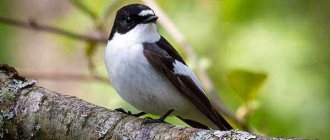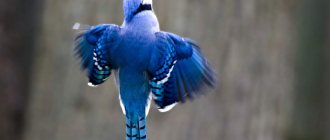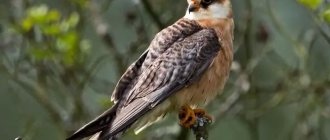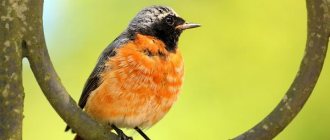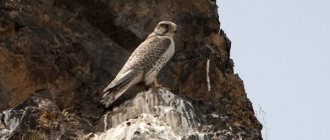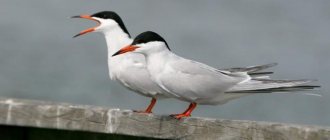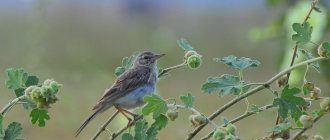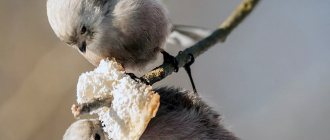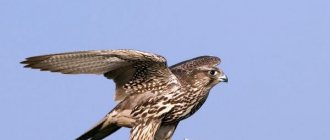This amazing bird was discovered by the famous domestic naturalist A. Middendorf in the early spring of 1845 during an expedition along the spurs of the Stanovoy Range in the Aldan River basin.
The scientist was familiar with the description of a new North American species of mountain grouse published by D. Douglas in the Proceedings of the Linnean Society of London in 1829. Therefore, he mistook the bird he encountered in the mountains for a mountain spruce grouse.
Middendorf was mistaken, and only 10 years later this misunderstanding was corrected by zoologist G. Hartlaub, who compared Middendorf’s specimens with North American birds. He proved that Middendorf had discovered a new species. The same Hartlaub was the first to highlight an amazing feature of the wing structure of the Asian spruce grouse: pointed outer flight feathers. This fact is reflected in the species name, which means pointed feathers. Subsequently, zoologist D. Elliott, based on this characteristic, identified the Asian spruce grouse as a separate genus.
External signs of Asian grouse
The size of the Asian grouse is slightly larger than the hazel grouse, but the body is denser. The weight of the bird reaches 730 grams.
Siberian grouse (Falcipennis falcipennis).
The plumage of the upper side of the body is a dark brown-chocolate tone, and the underside is covered with large white heart-shaped spots. These spots are absent only on the chest, which is uniformly brown in the male. Males are decorated with a clearly visible black throat patch with a narrow white border, as well as a small white patch behind the eye. The main feature of the Asian grouse is its pointed flight feathers, but they are difficult to see even with binoculars.
Kinds
The genus of spruce grouse unites three species, very similar in color, size and lifestyle: the Asian spruce grouse (common), which is found only in Russia in the Far East, and its two relatives living on the American continent - the Canadian spruce grouse and the mountain spruce grouse.
- The Canadian representative, as is clear, lives in North America. Its size is slightly smaller than usual - about 35 cm in length, weight from 450 to 600 g. It has a longer tail and wings, the apical feathers on which are not white, but brownish.
Its abdomen and lower body are also decorated with white markings along the chocolate field, but they do not have a “heart-shaped” shape, like our grouse. The black area on the chest of bettas is divided by an intermittent stripe into upper and lower parts. And its wing shape is not as sharp as that of the Far Eastern grouse.
Of all three species of the genus, Canada is the most common. It is found in Canada from the Atlantic to the Pacific Ocean, wherever coniferous trees grow.
- The mountain spruce grouse lives only in the coniferous forests of the Coridillera mountain system. It is very similar to the Canadian one, and at one time was even considered a subspecies of it. It differs only in the details of coloring and its special flight when mating.
The male flies vertically upward, sits on a large branch, assumes a mating pose on it and lingers there for some time. Flying off, it lands, having flown about 20 m. At the same time, the wings make two loud pops, and another one at the moment of landing. They live a little longer than other relatives, about 12-13 years.
Distribution of Asian Siberian Grouse
Siberian grouse is found in Sakhalin, the Far East, Yakutia and Transbaikalia. The habitat of the Asian grouse almost completely follows the distribution of the Ayan spruce. Its main part is located in the forests of two ranges - Sikhote-Alin and Stanovoy. In the north, the grouse grouse lives along the Okhotsk coast. In the west, the species’ habitat extends to the central sections of the Stanovoy Range, to the sources of the Oldoy River. The southern border is located in the Amur valley, only in its lower reaches the grouse grouse lives on the right bank and spreads through the forests of the Sikhote-Alin to approximately the 45th parallel.
The peculiarity of the grouse grouse is that it is not at all afraid of humans, and this has brought the species to the brink of complete destruction.
Breeding
Siberian grouse arrived at the Novosibirsk Zoo in 1986. The first eggs were laid the following year, and the first chicks were born in 1988. In just 15 years of work with this species, more than 500 chicks were obtained. Since 1988, work on studying the biology, breeding, and development of young animals has been carried out by the Novosibirsk Zoo together with the Institute of Systematics and Ecology of Animals SB RAS. By 2008, more than 100 captive-bred individuals were released into the mountain forests of Salair (Maslyaninsky district, about 100 km southeast of Novosibirsk) as an experiment to create a reserve population.
Sources: ru.wikipedia.org , zooclub.ru
Similar articles:
Siberian Crane
The Siberian Crane, or white crane (lat. Grus leucogeranus) is a species of crane endemic to the northern territories of Russia. Siberian cranes are endangered and are included in the international Red Book of the International Union for Conservation of Nature and the CITES Convention on International Trade, as well as the Red Book of Russia...
Red Book of the Republic of Sakha (Yakutia). Birds. part 2
…
White Owl
White owl, or polar owl (lat. Bubo scandiacus, Nyctea scandiaca). In Yakut - kaar-ebe, which means snow grandmother...
Pink seagull
The pink gull is such a rare bird that its discoverers, risking their lives, went to look for it in the cold northern waters, equipping special expeditions. The pink gull belongs to the gull genus of the gull family. This small, beautiful and fragile bird lives in the harsh regions of the Arctic. She chooses nesting sites in the lower reaches of cold northern rivers. She builds nests on the islands and banks of these deep streams flowing into the Arctic Ocean. Indigirka, Kolyma, Yana, Anadyr - these are the rivers that...
Grouse
Black grouse, or black grouse, or field grouse (lat. Lyrurus tetrix), is a common bird of the pheasant family, living in the forest, forest-steppe and partly steppe zones of Eurasia, including in Russia. Throughout the entire range there are sedentary or nomadic birds; settles on forest edges, along the edge of the forest, in the valleys of large rivers. Object of hunting...
Habitats of Asian grouse
The Asian Siberian Grouse lives in dense dark coniferous taiga on mountain slopes covered with wild rosemary or moss. The bird clearly prefers mountainous areas and is practically never found on the plains. For this attachment to the mountain landscape with rocks and screes, the spruce grouse is called the stone hazel grouse, stone grouse.
The bird can be found only at the tops of mountain ridges, where spruce and fir mixed with dwarf cedar form impassable thickets. In summer, growing broods feed on berry fields.
Mating behavior of Siberian grouse
During mating, the male fluffs up his black undertail, decorated with sparkling white feathers. Its mating dance consists of jumps and revolutions around its axis by 180-360 degrees. At the sight of a female, the displaying male “loses his head” and does not notice the danger at all.
The winter diet includes only pine needles, and in the summer - seeds, lingonberry leaves and berries.
Peculiarities of behavior of the Asian grouse
The Asian spruce grouse is not at all afraid of humans. When he approaches, the birds are in no hurry to fly away, but leisurely move away on foot or fly up to the nearest tree. They sit quietly when shots are fired, and allow themselves to be caught with a noose attached to a long stick.
Males click like wood grouse. The sounds are heard in a kind of ri. Then follows another sound, extremely unique, slightly modulating and reminiscent of the howling of the wind in a chimney. And again loud clicks.
The voice of the Asian grouse is very similar to the singing of the wood grouse.
Lifestyle
Siberian grouse considers the best place to be densely growing, impassable territories, the so-called rough taiga, on the slopes of mountain embankments, covered with moss or wild rosemary. It is best if it is a damp and ancient forest. Its affinity for rocky terrain and accumulations of rock remains also led to the appearance of other names for the grouse, such as stone hazel grouse or stone hazel grouse.
He tries to avoid the plains, but if the circumstances are such that there is no other choice, then he tries to find a larch forest or thickets of dwarf pine or Erman birch (another name for stone). Moreover, it is interesting that in winter the grouse tries to spend time in forests covered with coniferous trees, but in the summer months it is also found in deciduous trees. Asian Siberian Grouse thrive at altitudes up to 1.6 km above sea level. Closer to the period of breeding, grouse grouse try to find damp and dark lawns, densely overgrown with lingonberries, cloudberries and blueberries. They are great for the diet of growing babies. It is more comfortable for chicks to be on the ground, abundantly covered with dense moss thickets.
Female Siberian Grouse
Siberian grouse loves solitude and forms flocks (from 15 to 20 birds) only closer to the winter period, perhaps in order to feel calmer in cold times. But even so, they prefer not to communicate with each other, much less eat together. It becomes very attached to a certain part of the territory, which is detrimental for it, since if this place burns out or is cut down, the bird may even die. This type of bird is quite calm and rarely makes any movements or sounds (particularly in winter). She feels comfortable, sitting quietly in the crown of a tree so that few people can see her. Its lethargy and color contribute to this. This is precisely where she sees the main way out of a dangerous situation: to hide, to hide, and not to run away or fly away, shouting to the whole forest about the danger. And it must be said that this technique really works and grouse are only occasionally caught by predators, such as sables.
Dikusha quite calmly allows a person to come close to him. Sometimes it can move to the nearest branch, almost above the head of the object that disturbed it, and sitting calmly on it, examine it. At the same time, she doesn’t even freeze, but moves along the branch and turns her head curiously. The situation reaches the point where the grouse does not even understand the degree of danger when a noose attached to a stick entangles its neck. Shots don't scare her either. From everything said above, it is clear that this type of bird is a trophy for many lovers and hunters, which does not require much effort to obtain.
The bird is most often located in the lower part of the tree, not rising higher than two meters from the surface of the earth. Only with the onset of dusk does the grouse finally fly to the earth's surface in order to find night shelter. In winter, they dig something like a cell in a snowdrift and hide in it all night. It happens that the presence of crust does not allow the grouse to dig a hole in the loose snow, then it will die from frost or become the prey of a predator. Due to the fact that it is necessary to periodically dig up snow, at the end of the winter period the feathers on the wings of the grouse are worn off, because the snow is first raked with its paws, and then the wings help move inside the chamber. During mild winters, birds do not hide in the snow so as not to wet their plumage.
Young grouse chick
Birds move slowly and most often on foot. Even if frightened or feeling a threat, while on the ground, the grouse will either freeze (she has everything in order with patience), or will also begin to quietly move away from the object that caused the alarm. During the flight, the bird remains occasionally. And even if they fly, it is no further than 20–30 meters from the starting point of the flight. Moreover, the grouse can be recognized by the whistling sound that its wings make during flight.
Nesting of Asian Siberian Grouse
The female makes a nest in a secluded place in a fir-spruce forest under the cover of berry bushes, dead wood, or at the base of a tree trunk. The depth of the tray is 7 cm, the diameter of the tray is 17 cm. It is lined with dry cedar needles. In damp places, its thickness can reach 1.5 cm. In the second half of May - early June, the female lays 7-12 eggs measuring 46x32 mm. The shell is pale brown with numerous small brown spots.
The Siberian Grouse incubates very tightly, allows people to approach and even allows you to touch it with your hand. The chicks are born together, usually between June 25 and July 5. They grow quickly. The brood stays within a radius of about 100 m from the nest for the first month. In case of danger, the female does not move away the predator, but hides with the chicks or slowly moves away. At the age of 4 days, the chicks are already jumping, fluttering their wings, and at 7-8 days they are able to fly to the lower branches of trees. The male apparently does not take part in raising the offspring. Siberian grouse feed on spruce and fir needles and berries.
The clutch of Siberian grouse consists of 7-15 eggs of a pale brown color with an olive tint, which the bird incubates for 23-25 days.
Description
The grouse bird in its physique and behavior is something between a hazel grouse and a black grouse, but closer to the former. It is slightly larger than the hazel grouse, but smaller than the black grouse: its weight is about 600 grams. The length of the body including the tail is 43 centimeters. Her wings, like those of many other chickens, are blunt and short, but despite this, she flies quite quickly. The paws are covered with thick warm down, which protects the bird from the cold in severe Siberian frosts.
The plumage is darker in color than that of the hazel grouse. Chestnut-black color is the main background, and there are white, gray, reddish and pale ocher spots and streaks on it. Due to the larger number of light spots, females have a lighter color than males. Their feathers show more of a mixture of reddish tones.
The grouse birds, photos of which you see in the article, have a dense build and a small head. On the throat and part of the neck there is a white border on a black background. During the mating period, males have clearly visible red “eyebrows” above their eyes - these are areas of bare skin.
The species of these birds (grouse) has the following classification: the animal kingdom, the phylum of chordates, the class of birds, the order Galliformes, the family of grouse, the genus of the grouse.
Wintering of grouse
In severe frosts, grouse grouse crash gently into the snow, braking with their chest and tail. After landing, the bird sits motionless and looks around for 6-17 minutes. Then she slowly burrows into the snow with wave-like movements and digs a tunnel. In the snow, the grouse constructs a chamber with a height of about 14 cm and a ceiling thickness of 6 cm and settles down for the night; the whole process takes 8 minutes. In the morning, the grouse leaves the chamber, having previously examined the surroundings, and only after that it flies up to the selected spruce peak.
Reasons for the decline in the number of Asian spruce grouse
Currently, the main damage to the grouse is caused by human activity. It destroys the original habitats of birds, cutting down the most valuable species - spruce and fir. When developing taiga areas, the grouse grouse, due to its vulnerability, is the first to disappear. In addition, people either directly kill birds, using them as food or as bait in hunting traps. The Asian Siberian Grouse falls prey to various predators more often than other grouse.
Siberian grouse are polygamous, and a mating male can mate with any of the females in his area.
Protection of wild grouse
The Asian spruce grouse is listed in the Red Book of the Russian Federation. The species is protected in the Bureinsky, Sikhote-Alinsky, Zeysky, Komsomolsky, Poronaysky, Dzhugdzhursky nature reserves, as well as in the Tundra and Northern nature reserves on Sakhalin Island. Successfully bred in the Novosibirsk Zoo. The relict species does not get along well with people. Attempts to breed her in enclosures were unsuccessful. Only one thing can be said: the existence of Asian Siberian Grouse in the future can only be ensured by a network of reserves, open-air cage breeding and ecological culture of the population.
If you find an error, please select a piece of text and press Ctrl+Enter.
Interesting Facts
- Far Eastern local hunters try not to kill this bird if they encounter it at the very beginning of the hunt. This does not happen out of a kind attitude towards the bird itself, but as a result of concern for the next traveler, who may be very weak and hungry. Such a reserve is useful to a tired person; it is an easy prey. It’s not for nothing that the bird is also called “the hunter’s breakfast.”
- Siberian grouse are hunted mainly for the sake of a trophy, since its meat is noticeably bitter. After all, she eats pine needles all her life.
- Despite the apparent availability of the bird, it is not so easy to meet it. You can see and approach it only by accidentally stumbling upon it in the forest. Special searches will not lead to anything - she is really well camouflaged.

